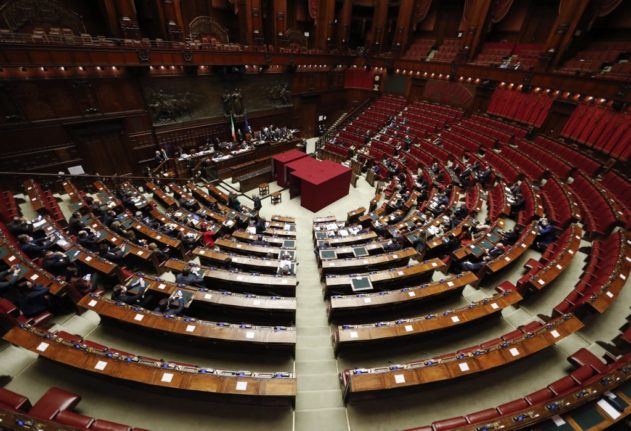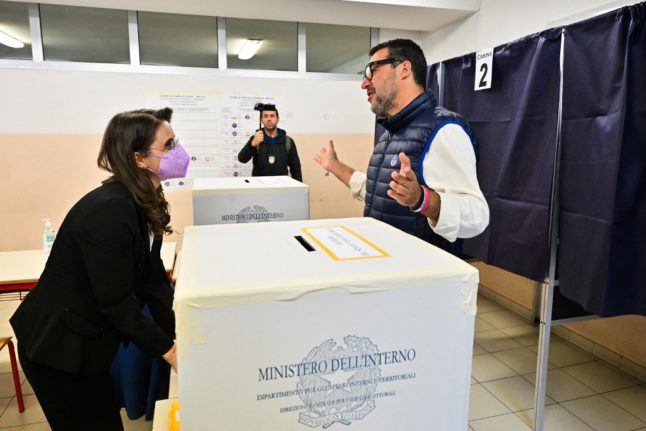The right-wing alliance of parties led by Giorgia Meloni’s post-fascist Brothers of Italy is expected to win the September 25th general election by a landslide.
In fact, the question many people have been asking for a while now is not whether the right will win, but by how much.
READ ALSO: Far-right Brothers of Italy eyes historic victory as Italy votes
The right-wing bloc, led by Meloni’s post-fascist Brothers of Italy and also including Matteo Salvini’s League and Silvio Berlusconi’s Forza Italia, is expected to easily win a big enough share of the vote to take a majority of the seats in both houses of parliament and form a government.
But will they win a simple majority or a ‘super majority’? Here’s a quick guide to how the system works, what the difference is, and why it matters so much.
What’s a simple majority?
A government with a simple majority has the support of just over half of either the Senate or the Lower House – so at least 201 seats in the House and 101 in the Senate (not counting the six senators for life).
Getting a large enough share of the vote to ensure this is already quite an achievement in Italy, where the electoral system is set up to favour coalition governments precisely in order to stop any one party from ending up with too much power (it was, after all, designed after WW2 and the fall of Mussolini’s Fascist regime).
READ ALSO: Is Brothers of Italy a ‘far right’ party?
So under this system, the party that takes the largest share of the vote still needs help – a coalition partner, or several – to get a majority of seats in parliament and form a workable government. This usually requires major compromise and sees parties striking difficult bargains with others from across the political spectrum.
This time, the right-wing alliance looks more than likely to win by a landslide and take a majority between them – in which case it won’t need to seek outside support.
Some political analysts predict that Meloni and Salvini’s parties will win enough seats to form a government on their own, without involving Berlusoni’s more moderate party. They might choose to join forces anyway – but the more parties involved, the less stable a government is.
And, with a smaller number of parties involved, it would basically be easier for a government to pass the laws it wants to pass. (That is of course discounting the still enormous potential for bickering and power plays between even just a few coalition partners.)
So what’s a super majority?
Known more officially in Italy as a maggioranza speciale o qualificate (special or qualified majority) a ‘super majority’ is a two-thirds majority of the seats in both houses of parliament.
The prospect of Italy’s right-wing parties reaching this threshold has been hotly discussed in the media, since a government with such a large majority would be able to make changes to the political system itself, and therefore the constitution, without consulting voters via a referendum.
EXPLAINED: Who’s who in Italy’s general election?
A political force achieving a majority large enough to change the constitution would be unprecedented in Italy’s postwar history, and could bring major changes to the country’s political system – including to how the president is elected, or the powers the prime minister has.

All three leaders of the right-wing alliance have called for Italy to adopt a ‘French-style’ system which would mean the president is directly elected by voters,, instead of by lawmakers as is currently the case. This would mean changing the constitution.
Which scenario is likely?
If the most recent polls are to be believed, the right is on course to easily win a simple majority and possibly go on to reach the two-thirds threshold.
Talk of a super majority came about as the last polls (published two weeks before election day, when a polling blackout began) showed the right-wing alliance was just two or three percent away from achieving the share of the vote needed to give it a ‘super’ or qualified majority of the seats in both houses of parliament.
The right was polling 19 percent ahead of the centre-left bloc, and will need a lead of at least 21-22 percent to secure a qualified majority in both houses, according to projections by Youtrend/CattaneoZanetto & Co.
READ ALSO: An introductory guide to the Italian political system
A two-thirds majority is “possible” for the center-right “if the advantage in both chambers is around 21-22 percent,” Youtrend’s analysis explains.
Such a majority then becomes “probable” with “an advantage over the center-left of more than + 26 percent”, it says.
The winning alliance will need a majority in both houses of parliament, the Chamber of Deputies and Senate, and taking a majority in the Senate is forecast to be more of a challenge.
Recent reforms mean parliament has shrunk by a third: there will now be 400 MPs in the Chamber instead of up to 630, and 200 Senators instead of 315.

Italy has a fiendishly complicated hybrid voting system: about 36 percent of seats in both houses of parliament are allocated in a first-past-the-post vote in single-member constituencies, while the rest are elected by proportional representation via party lists of candidates.
If you want to see what this looks like, try out Sky TG24’s seggiometro, or ‘seatometer’, which allows you to visualise how different election results would translate to seats in parliament.
Is there any chance of a surprise result?
This definitely hasn’t been an election campaign that has kept us on the edge of our seats. The right-wing bloc led by Giorgia Meloni has been expected to win all along – but voter sentiment has apparently shifted somewhat in the two weeks since polling blackout began.
Since the publication of opinion polls ended, support for the left-leaning Five Star Movement appears to have surged while the hard-right League is flagging, according to pollsters interviewed by Reuters this week.
Most said the prediction that the right will take a majority in both houses of parliament and form the next government remains by far the most likely outcome, even if it has been thrown into doubt somewhat by Five Star’s rise.
With Italy’s famously unpredictable politics, and many voters expected to make their minds up only on the day itself, nothing can ever really be ruled out.



 Please whitelist us to continue reading.
Please whitelist us to continue reading.
Member comments